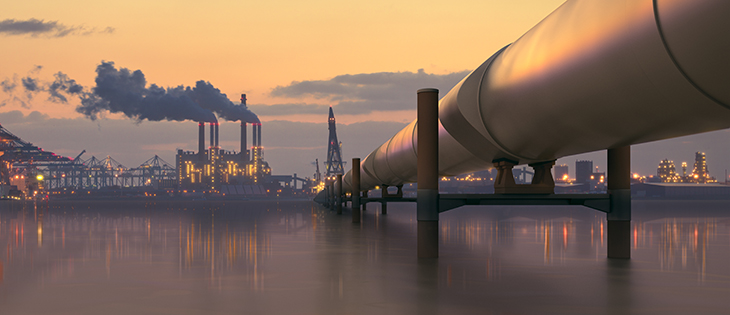Between a Rock and a Hard Place: An Oil and Gas Industry in ‘Purgatory’
The middle-market energy sector is facing myriad challenges from geopolitical events, weather, well depletion, talent acquisition and low prices.

Leading up to late 2014, a barrel of oil typically cost $90 to $100. Flash forward to today, and prices are half that, leaving the oil and gas industry struggling. Catastrophic events have bruised the industry further; most recently, Hurricane Harvey made landfall in Texas, a hub for many energy companies. Meanwhile, geopolitical turbulence in Venezuela cut off a supply of oil for many U.S. refiners.
MMG spoke with Brian Williams, a partner with investment bank Carl Marks Advisors, to learn more about how middle-market oil and gas companies are faring and the state of M&A activity in the industry.
You can find his insights on the impact of Hurricane Harvey in an earlier interview.
Q. You’ve spoken with MMG about the impact of Hurricane Harvey on the oil and gas industry. What are some of the other domestic forces you’re watching?
Brian Williams: Personally, I’m focused on the depletion and decline rates for a lot of the wells in the Permian Basin, which may no longer be as economically attractive as they once were.
You’re starting to hear people whisper about the underperformance of some wells, and I think that might be as big a theme as any. People have been projecting these reservoirs to be very homogenous and very easily reproduced. They’re continuing to use new technologies and processes to get more and more production out of the same well board, but you’re starting to see some of those limits, as well as people getting into some less productive acreage.
When the downturn in prices hit several years ago, everyone was going to drill their sweet spots and complete them as cheaply as they could because services were cheap. But I think you’re going to start to have lower quality rock and you’re not going to get as much production per dollar invested. I think that’s as big of a near-term issue as some of the geopolitical issues with OPEC production cuts.
“You’re starting to hear people whisper about the underperformance of some wells, and I think that might be as big a theme as any.”
Q. Which longer-term trends are you keeping an eye on?
BW: I think there’s been such a massive underinvestment in hydrocarbon infrastructure since the downturn began about three years ago that I don’t know that you can catch up.
Looking at the bigger picture, you have tremendous underinvestment globally in hydrocarbon production. We have excess capacity built up all over the world. At the same time, we have the shale revolution, so oil production has ramped up dramatically in the United States. But as the U.S. starts to require a higher price, or we begin pulling back on our production, I think there’s as good a case as any that the surprise will be on the upside for oil prices. It might be wishful thinking on my part, but that’s a thesis that I don’t think is getting talked about as much as I would have thought.

Q. You mentioned OPEC earlier—what are some of the geopolitical issues you’re keeping an eye on?
BW: You can’t overstate how disastrous the societal, political and economic implications are in Venezuela, and their impact on the country’s output is a sign. A large portion of U.S. refining capacity was built to handle heavy, sour, nasty crudes from Venezuela. Refiners are not easily turned around to run lighter, sweeter crude grades. Those might be what’s available if Venezuela is not exporting as much, which is going to be the reality for some time.
Meanwhile, OPEC compliance with production cuts remains one of the bigger themes out there that everyone is talking about.
Q. When prices fell during the downturn, companies adopted technology to try to lower their costs and remain competitive—have those technological gains been exhausted?
BW: None of the technologies being used is a secret. Everybody copies everything that works in the oil field. If there’s an advantage, it doesn’t last very long.
I think what you’re truly seeing are some people that are pushed to the outer limits in terms of well spacing, and the reservoirs that we’re entering might not be as productive as others.
Everything’s ramping up and there’s tons of activity, particularly in the Permian, so people are going to have to start drilling rock that’s not the best anymore.
It’s not the technology at fault. It’s that you’re trying to perform at the same level, or improve performance out of the reservoir, out of a rock formation that’s not capable of it no matter what you do.
Q. Finding the right talent has been an issue for middle-market companies across sectors. Is the oil and gas industry facing this problem too?
BW: Yes. On the producer side, if you’re a petroleum engineer, you’re a petroleum engineer—it’s hard for you to go be a manufacturing engineer or something else. You’ve got your specialty and your expertise. If you’re really good at that, then you’re going to have your job, and a lot of companies have been short-staffed for a while in the face of attrition and retirements.
Where it’s been most noticeable is in the oil services landscape, where guys who were out working in the oil field were attracted several years ago by great pay—to go drive a truck and make $200,000 a year, for example.
A lot of that magic is gone. When jobs came back after the downturn, wages didn’t go up dramatically. There’s clearly been some wage inflation, but it hasn’t been substantial across the board; there have been struggles attracting talent back to the industry. We’re certainly seeing labor challenges—not shortages—but the experienced talent pool that was out there, that companies wanted to bring back and who wanted to come back, was just about exhausted.
At the peak of activity, we had 2,000-plus rigs running. We’re at about half of that now. You would think if we had enough people to run 2,000 rigs, we’d have enough to run 1,000 for sure. But it’s been a bigger challenge to attract people back into the industry.
I’m hearing, more than I would have thought, of oil services companies that are hiring green talent and having to train them. There are not as many experienced hands around as you would have thought.

Q. What levels of M&A are you seeing in the middle-market oil and gas industry right now?
BW: I would term activity as having been reduced somewhat. While there’s still activity, it’s been negatively impacted by the uncertainty around commodity prices and the resumption of oil field activity growth, and eventual pricing growth.
If you look at share prices of oil field services companies, they’ve fallen dramatically in the last five or six months. In the beginning of the year, easily most public oil services companies’ share prices were up by half. They had risen dramatically with the expectation of the growing rig count and increasing activity.
What’s happened is that pricing hasn’t recovered as much as people had hoped. Although activity picked up, it hasn’t been a rocket ship. Rig count has been trending sideways for about a month, so the magnitude and velocity and eventual levels of oil field activity got a little more negative.
Q. What are you hearing from buyers and sellers?
BW: The public share prices have contracted, leading sellers to say “Hey wait a minute, my business is actually doing better month over month still; I’m not interested in selling.” I think buyers are still out there and interested if they can get a deal, but they’re not as interested in paying the price.
“Everyone is taking a bit of a pause—it feels like we’re in a perpetual state of purgatory where we don’t have a sense that oil prices are going to be good enough to ramp activity up, but they’re not low enough to where you think activity’s going to crater.”
To get deals done, you have to have an environment where you have enough buyers and sellers who can agree on the value of something, and I think that’s gotten harder in the last month as rig count has gone sideways and oil prices have gone from the low $50s to mid $40s.
There are clearly deals going on. You have real strategic synergies, or someone who has an interesting product or service line that somebody wants to buy and own.
Q. Are there subsectors of the industry where you’re seeing heightened activity?
BW: There was a real push by exploration and production companies to get back to work, which led the service guys to try to respond to that. But I think today we’re in kind of a middling environment where things have gotten better, but nobody’s doing really well.
Nobody’s really excited for the future. Everyone is taking a bit of a pause—it feels like we’re in a perpetual state of purgatory where we don’t have a sense that oil prices are going to be good enough to ramp activity up, but they’re not low enough to where you think activity’s going to crater. Everybody’s just waiting to see some direction definitively one way or the other. That’s what’s created a lot of the uncertainty that’s caused M&A activity to trend sideways here too, and not to accelerate more rapidly.
This Q&A was edited and condensed for clarity.

Brian A. Williams is a partner with investment bank Carl Marks Advisors. He has over 20 years of oil and gas investment banking, strategic advisory and operating experience focused on oil field services mergers and acquisitions, public and private capital raises, restructurings, principal investing and executive management.


